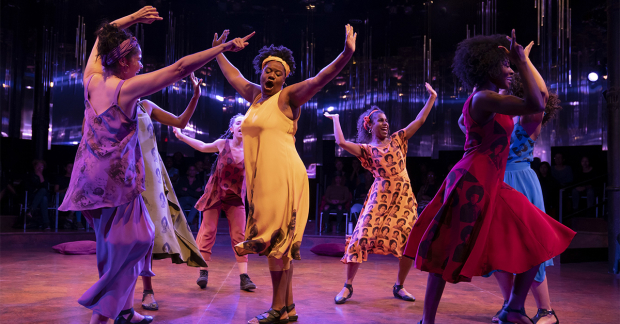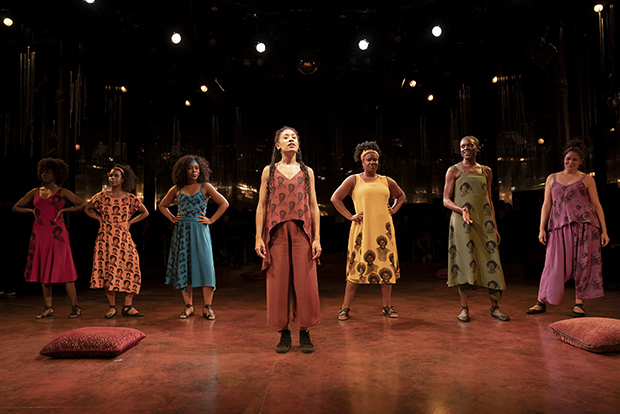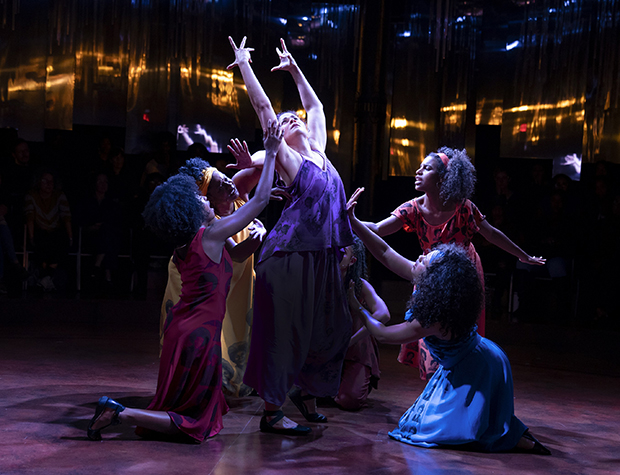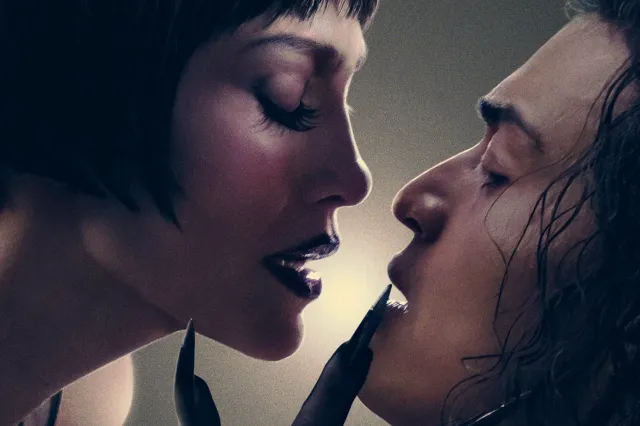Ntozake Shange's For Colored Girls … Is Still a Tragic, Joyous, Metaphysical Dilemma
The 40-year-old poetic play returns to its early home at the Public Theater under the direction of Leah C. Gardiner.

(© Joan Marcus)
Ntozake Shange died one year ago, before she could see her revolutionary "choreopoem" For Colored Girls Who Have Considered Suicide/When the Rainbow Is Enuf explode back onto the Public Theater stage like a volcano that's been quietly building pressure for 40 years.
For Colored Girls first opened at the Public Theater in 1976, followed by a nearly two-year run on Broadway — a rare feat for any production, let alone an abstract piece of performance art about the black female experience. Being such a significant event in theatrical history, the play's homecoming could easily have been presented as a dirgelike memorial to its late author, or a museum piece dusted off for posterity. Director Leah C. Gardiner, fortunately, seems to have too much love for the piece, and a live investment in what it has to say, to let it fall into either of these sterilizing traps.
She's also too wise to frantically grasp for ways to make For Colored Girls "relevant" in its new 21st-century Trumpian #MeToo era. You don't need pussyhats or the sounds of racist battle cries from Charlottesville to understand that Shange's poetry is just as penetrating now as it was 40 years ago. Gardiner's production fully trusts in that lasting power and accentuates it with an extraordinary cast and creative team (entirely female for the record, if there are still any gender parity nay-sayers out there).
For Colored Girls is essentially a collection of monologues, tethered by song and dance, and delivered by a rainbow of women: Sasha Allen (Lady in Blue), Celia Chevalier (Lady in Brown), Danaya Esperanza (Lady in Orange), Jayme Lawson (Lady in Red), Adrienne C. Moore (Lady in Yellow), Okwui Okpokwasili (Lady in Green), and Alexandria Wailes (Lady in Purple). There is no weak link in this colorful ensemble, each one of their performances blending moments of ecstasy, rage, sorrow, and confusion into a beautiful mosaic of unique yet universal experiences.

(© Joan Marcus)
As Shange succinctly and famously says through the Lady in Yellow (an ensnaring performance by Moore), "Bein alive and bein a woman and bein colored is a metaphysical dilemma I haven't conquered yet." Inside the chaos of this personal riddle is at once abundant tragedy and boundless joy — even in the speech that Lady in Orange (a poignant Esperanza) declares a "requium" [sic]. Lady in Brown (a playful Chevalier) delivers a wholesome ode to Toussaint Louverture. Okpokwasili recites the monologue of self-reclamation, "somebody almost walked off wid alla my stuff." Lawson leaves us haunted with the story of domestic abuse in "a nite with beau willie brown" (performing that daily is a feat of emotional and physical endurance). Wailes shows the breadth of expression in American Sign Language in her performance of "sechita." And Allen lends her astonishing vocal abilities to new music composed by Martha Redbone, ending with a song of worship for the divinity in herself and her sisters.
Even more than the stunning monologues that have undoubtedly gotten many a young actor into Juilliard, For Colored Girls is associated with the community it builds around it — a kinship experienced within individual companies as well as by the generations of people exposed to and moved by the piece. Camille A. Brown's choreography for this production speaks to both, fortifying the molecular connections between each of the women onstage while bridging the gap between traditional African-American social dance and modern hip-hop.
Toni-Leslie James's costumes build a similar link, capturing a legacy of pain and triumph in the simplest of ways. She has created a collection of monochromatic dresses and rompers imprinted with the faces of beloved female family members of the actors who don their likeness. What a beautiful way to honor a lineage, and what a wonderful way to induct those personal threads into Shange's transcendent society of strong, resilient black women.

(© Joan Marcus)







